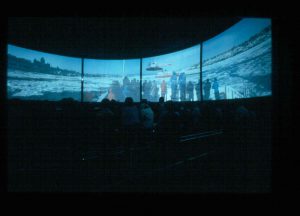

(Photo Credit CinemaExpo67.ca)
On June 21st The Musée d’art contemporain de Montréal hosted a talk with Graeme Ferguson and Janine Marchessault as part of their In Search of Expo 67 exhibition. Unfortunately Graeme was unable to attend the talk and his son Munro Ferguson, a member of the Elastic Spaces network, spoke on his behalf. As such, the talk discussed Ferguson’s co-creation of the IMAX cinematic experience as we know it today, as well as the documentary film Polar Life (1967) shot and directed by Ferguson himself, and first exhibited at the Expo 67 the “Man the Explorer” pavilion. In its exhibition, Polar Life debut as a multi-screen work consisting of eleven stationary screens arranged into a circle. Inside the circle of screens housed four theatres were positioned on a 360 degree rotating platform. The apparatus served as a way for the viewers to experience all eleven screens. In its creation, Polar Life was unique in its sensitivity to the viewer, and as such it worked to not overwhelm its spectators.
Polar Life is also considered to be a “cinema verite” work, as it was shot intuitively, unscripted and sought to capture the life and culture of the locals within the Canadian North, Alaska, Lapland, and Siberia. As Ferguson suggested, the 360 degree rotating axis also served as a metaphor for the North and South pole, as well as the circle of life.
Marchessault and Ferguson then discussed the idea of the multi-screen format as a medium itself. As such, Ferguson stated that the multi-screen format is in a sense a form of visual or cinematic poetry, largely because within the space between two screens, a metaphorical image is created by the viewer. As Ferguson, also suggested, multi-screen projections appeared as the beginnings of immersive experiences.
